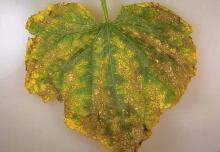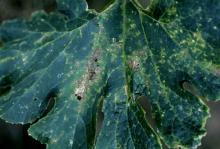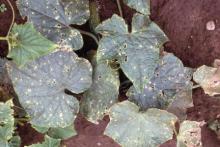Cause Pseudomonas syringae pv. lachrymans, a bacterium that overwinters in diseased plant material and on seed. It is spread by rain, sprinkler irrigation, and on workers' hands and clothing. In recent years, using tolerant varieties has reduced disease incidence.
Symptoms Leaves, stems, and fruit may be affected. The leaf spot is irregularly shaped with a water-soaked appearance; bounded by the leaf veins the shapes of spots are angular. Bacteria may ooze from the spots in droplets, which dry to a white residue. The water-soaked area later turns gray and dies. Often, dead tissue is torn away from the healthy portion, leaving large, irregular holes. Water-soaked spots on fruit are smaller than on leaves, and they are circular. Lesions usually are superficial, but the injury may permit entry of soft-rot organisms. Affected tissue becomes white and may crack open.
Cultural control The following control program is a combination of those used in other areas.
- Use clean, bacteria-free seed.
- Practice a 2-year rotation out of cucurbits.
- Plant resistant varieties. Pickling varieties Regal, Royal, Pioneer, Express, Calypso, Cross Country, and Frontier have shown tolerance under Washington and Oregon conditions. Slicing varieties Victory, Bel Aire, Raider, Encore, Poinsett 76, Slice Nice, Dasher II, Turbo, Quest, and Sprint-N are resistant.
- Stay out of wet, infected fields.
- In the Hermiston, OR area, do not irrigate with water draining from another cucumber field.
Chemical control
- Actigard 50WG (Group P1) at 0.5 to 1 oz/A on 7-day intervals. May be applied the day of harvest. 12-hr reentry.
- Applying fixed-copper products (Group M1) has reduced disease spread but reportedly has caused some stunting and leaf chlorosis in Oregon.
- Badge SC at 0.5 to 2.5 pints/A on 5- to 7-day intervals. Preharvest interval is 0 days. 24-hr reentry for greenhouse use; 48-hr reentry for all other applications.
- Bonide Liquid Copper is available for home gardens. H
- Cueva at 0.5 to 2 gal/100 gal water on 7- to 10-day intervals. May be applied on the day of harvest. Poor control as a stand-alone product. 4-hr reentry. O
- Cuprofix Ultra 40 Disperss at 1.25 to 2 lb/A on 5- to 7-day intervals. 48-hr reentry.
- Kocide 2000 at 1 to 2.25 lb/A or Kocide 3000 at 0.5 to 1.25 lb/A on 5- to 7-day intervals. 48-hr reentry. O
- Liqui-Cop at 2 to 3 teaspoons/gal water. H
- ManKocide at 2 to 3 lb/A on 7- to 10-day intervals. Under moderate to severe disease pressure use the higher rate on 5- to 7-day intervals. Do not apply within 5 days of harvest. 48-hr reentry.
- Nu-Cop 50 DF at 1.5 to 2 lb/A. 48-hr reentry. O
- Previsto at 0.75 to 2 quarts/A on 5- to 7-day intervals. 48-hr reentry. O
- Seed treatments may help if affected seed is used.
- Hot water treatments with various chemicals (calcium propionate at 4.4 oz/gal water; acidic cupric acetate at 6.7 oz/gal water) for 20 minutes at 122°F reduced the frequency of disease in cucumber seedlings, but did not completely eliminate the pathogen. Hot water alone is not effective.




